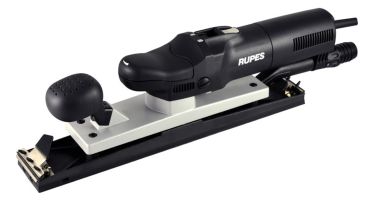Choosing The Best Sander - Sheet Sanders
When choosing a sander there are a lot more factors to consider than brand and price. These will include shape, size, power, orbital or random orbital, orbit size, variable speed, dust extraction but most importantly its intended purpose.
To help with choosing your sander there are several factors, the first being the shape or style of the sander. There are many shapes available including triangular, round, square, rectangular etc and they all serve different functions. Too often a sander is purchased based on the perceived benefit of that shape, rather than its practical application.
Today we look at Sheet Sanders:
Sheet sanders being larger in size are typically used for industrial applications in the marine, automotive and furniture making industries. Their larger size makes them ideal for sanding bigger surfaces, faster and with less abrasive changes.
Powerful and suited for all sanding from aggressive stock removal using 40gt abrasives through to fairing and finishing with 400gt, these sanders are designed for vigorous work. Always choose a sander that allows connection to an active dust extractor as this will dramatically improve performance.

The Shape
Sheet sanders come in a variety of sizes including 70mm x 198mm, 115mm x 230mm and specialist sanders like the Longboard at 400mm x 70mm. The larger base size of sheet sanders makes them an ideal choice for bigger surfaces like boats, furniture, cabinetry and automotive applications.
Power (Watts)
High performance orbital sanders are equipped with powerful motors, designed for working on a vast range of materials under heavy duty working conditions. Ranging from 350W to 550W, these sanders have an excessive amount of power to get the job done, but the trade off is they typically weigh between 2 - 3kgs. +
New brushless motors provide higher power outputs with greatly reduced weight with sanders like the Mirka DEOS 383CV weighing only 1.0kg
Orbit
The orbit of a sheet sander will vary considerably, the main factor being the size of the base and the power of the sander. The Rupes SSPF and Rupes SSCA are both Half Sheet Sanders that have a 5.0mm orbit designed specifically for grunt work, all day - everyday, while a finishing sander like the Metabo SRE4351 has a 2.2mm orbit and is best used with finer grits

Pad Savers And Dust Extraction
Sheet sanders get their name because they can easily be used with sandpaper sheets and rolls, however if these do not have holes they will not provide dust extraction. Where possible you should always use precut sheets with dust extraction holes, or net abrasives and connect to an active dust extraction system. There are multiple benefits of doing this including reducing labour and consumable costs, a much cleaner workspace, as well as being better for you and the environment.
Tip: Pad savers are a sacrificial pad that extends the life of the main backing pad and far cheaper than replacing backing pads.
Click Here To Learn More About Pad Savers
Advantages Of A Sheet Sander
Powerful, reliable and purpose designed for larger areas, the larger shape of the baseplate enables fast removal of material, a good surface finish and excellent “flattening off” on large flat surfaces. Choose your grit and get sanding.
Disadvantages Of A Sheet Sander
The bulky size and heavy nature of these sanders makes them very large surface specific.
Click Here To See Our Range Of Sheet Sanders
Happy Sanding!
If you have any questions please get in touch Ask Matt

